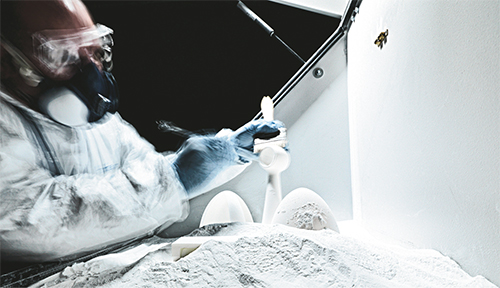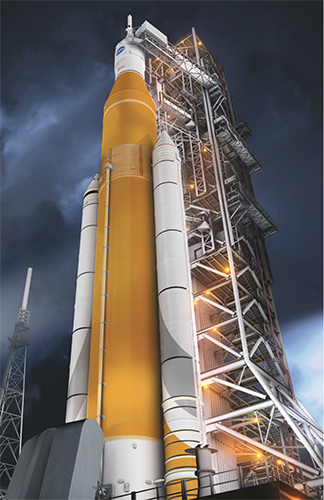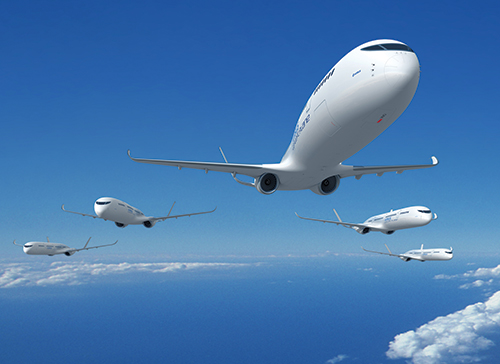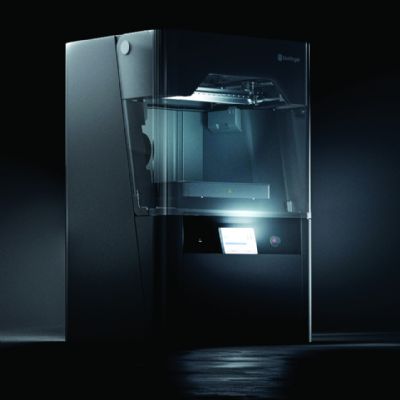• With so many proprietary systems and materials on the market, flexibility to produce across various platforms to ensure part quality and repeatability can be expensive and time-consuming.
• No common quality standards, or methods to verify quality, exist.
• Engineers are still learning how to design for 3D printing.
The pros and cons of 3D printing, along with examples of the technology in action, permeated the conference room at The Double Tree by Hilton in Los Angeles this past October, as aerospace-industry professionals and researchers gathered for the 3rd Additive/Aerospace Summit. Presented by Infocast, the summit featured speakers from federal agencies, colleges and research labs, and from commercial employers of the technology. Discussion of metal 3D printing comprised a significant portion of event presentations, with speakers representing aerospace heavyweights such as NASA, Airbus, Deep Space Industries, Raytheon, United Launch Alliance, CalRam and others.
Missile Mission Accomplished with 3D Printing
Raytheon Space and Airborne Systems offered its take on additive manufacturing, with Kelly Dodds, its technical area director of mechanical, materials, structures and manufacturing, pointing out that the company is betting big on the technology. And that bet is paying off.
 |
| An Airbus technician removes powder from a 3D-printed part. Airbus Group already has delivered what it claims to be the first 3D-printed spaceflight part, a titanium antenna-support bracket used aboard a satellite. At an Airbus division, Airbus Group Innovations, a team is exploring titanium powder, aluminum alloys, nickel and plastic as the raw materials for additive manufacturing. The goal is to obtain an inexpensive powder for production of vastly more parts. Photo courtesy of Airbus Group |
Raytheon researchers already have created nearly every component of a guided weapon using 3D printing, including working rocket engines, fins, guidance- and control-systems parts, and more. It’s all part of a push by the company into additive manufacturing as engineers explore the use of 3D printing to lay down conductive materials for electrical circuits, create housings for gallium-nitride transmitters and fabricate fins for guided artillery shells. The process enables rapid creation of designs and rapid alterations to be made as only the digital model of a part needs to be changed. As long as the part remains within parameters set by the 3D-printing process, new parts can be created in days instead of weeks, greatly shrinking the times and costs normally associated with R&D.
“You can design internal features that might be impossible to machine,” says Raytheon engineer Travis Mayberry, who is researching future uses of additive manufacturing and 3D printing, in a release detailing company efforts. “We’re trying new designs for thermal improvements and lightweight structures—things we couldn’t achieve with any other manufacturing method.”
And the company lists other positives to the burgeoning process.
”When we print something, we have fewer piece parts, so the supply chain becomes simpler,” says Leah Hull, Raytheon additive manufacturing manager. “Development cycles become shorter; we are getting parts much faster. We can get much more complex with designs because we can design angles that can’t be machined into metal.”
Wherever the technology leads, its success will rely on dependable manufacturing.
“Ensuring consistent production integrity,” says Dr. Teresa Clement, a Raytheon materials expert, “will be part of the next steps in realizing this vision.”
At that point, “you could potentially have (3D printing) in the field,” adds Jeremy Danforth, a Raytheon engineer. “That’s the vision.”
But before there’s the ability to print a missile in the field, “we need quality-controlled processes to fabricate all the component materials: the metallic strongbacks, and the plastic connectors, the semiconductors for processors, and the energetics and propulsion systems,” Danforth continues. “The hard part then is making the connections between these components. There are folks in industry printing warheads. We are printing demos of many of the seeker components. And we demonstrated a printed rocket motor. We’ve already printed 80 percent of what would go into a missile.”
In the conference presentation, Raytheon’s Dodds brought up an interesting point about the key role additive manufacturing will play in meeting strategic needs in aerospace and defense. As concerns about technological superiority mount, priority will be given to reduced cycle times, where more risk is accepted in exchange for speed. This vision bodes well for additive manufacturing, where its ability to shorten R&D time and quickly deliver workable prototypes and limited-run components and systems puts it in a leading-edge position among production processes.
 |
| This image depicts the NASA Space Launch System, under development and expected to provide the heavy lifting for proposed asteroid and Mars missions. NASA has been investigating the use of metals for 3D printing, build parameters, industry variation and more, and is leading the charge for standards and certifications leading to process certifications, a material database, and configuration and control mechanisms and procedures. Photo courtesy of NASA |
Dodds also cited a National Research Council Report, Application of Lightweighting Technology to Military Vehicles, Vessels, and Aircraft, which stresses the use of additive manufacturing:
“The (Department of Defense) should establish broad manufacturing initiatives…that encompass a variety of lightweighting strategies, materials and technologies, with the goal of achieving quantum improvements in performance, affordability, sustainability and reliability. The manufacturing challenges to be addressed include joining technology, parts consolidation and miniaturization, tool-less fabrication of low-volume production parts (using, for example, rapid prototyping/additive manufacturing and direct-material deposition technologies), improved nondestructive evaluation methods, and virtual process modeling.”
Airbus All-In on Space, Air Applications
Amy Glover, principal spacecraft structures engineer for Airbus Defence and Space, noted that her company employed the world’s first additive-manufactured flight component in September 2011, a titanium upper bracket of an antenna-support structure. The part is still flying, aboard the broadcast satellite Eutelsat 7 West A. This has propelled the company into other additive-manufacturing applications such as a titanium (via powder-bed laser melting) antenna foot bracket to be launched aboard a telecommunications satellite in 2017.
Airbus Group currently is producing a number of flying plastic 3D-printed components and, as noted, has manufactured certified titanium parts. The group expects to produce layered aluminum and superalloy parts. This process produces only 5 percent waste material, according to company officials. At an Airbus division, Airbus Group Innovations, a team is exploring titanium powder, aluminum alloys, nickel and plastic as the raw materials for additive manufacturing. The goal is to obtain an inexpensive powder for production of vastly more parts.
Challenges abound in space applications, as Glover noted. Launch payloads are limited in volume and mass, and parts must be robust enough to withstand excessive mechanical loads and stiff enough to withstand vibration. In space, where pointing stability is paramount for positioning antennae, cameras and solar panels, a part cannot exhibit excessive thermo-elastic distortion. And given the vacuum of space, part material must be resistant to outgassing and sublimation. Of course, the remoteness of space demands extremely high part reliability. In Glover’s view, flexibility in design, materials and processes lends additive manufacturing to space applications.
She pointed to one example, the optimization of a four-part structural bracket, with 44 fasteners, slated to be aboard a Eurostar E300 telecommunications satellite scheduled for a 2017 launch. Airbus Defence and Space was able to redesign the bracket and produce it via powder-bed laser melting as a one-piece aluminum part, weighing 35 percent less and with a 40-percent increase in stiffness. The process also cut at least 40 percent from manufacturing time. This meshes with the program goal to additively manufacture 25 percent of suitable Eurostar satellite components by 2020.
NASA: More Work Needed
“Available requirements will not mitigate additive manufacturing part risk to a level equivalent to other processes for some time to come,” explained Chris Singer, engineering director at NASA Marshall Space Flight Center. A limited process history translates to unknown failure modes, and with additive manufacturing being an open-loop process, in his words it requires closure or more feedback. He also noted thermal processing, surface quality, part cleaning, quality testing and vendor quality as other concerns.
Marshall Space Flight Center has a stated goal of the certified and safe flight of additively manufactured hardware, so Singer, despite listing the challenges, was optimistic of a 3D-printed future in space. The center has been investigating the use of metals for 3D printing, build parameters, industry variation and more, and is leading the charge for standards and certifications leading to process certifications, a material database, and configuration and control mechanisms and procedures.
Many AM Opportunities for Launch Vehicles
United Launch Alliance (ULA), a 50-50 joint venture of Lockheed Martin and Boeing, has, through its Atlas and Delta programs, provided expendable launch vehicles (ELVs) for U.S. government customers. Greg Schiller, responsible for strategic planning and business development at ULA, outlined three main applications for additive manufacturing in ELVs: tooling, fixtures and ground-support equipment; mockups and rapid prototyping; and flight hardware. He noted that hundreds of nonmetallic tools had been 3D-printed (fused-deposition modeling), bringing significant cost and time savings. The ability to print for prototyping brings similar savings, from months to weeks, between a model concept and an accepted design. ULA is looking to not only add polymer machines to meet increasing demand, but also increase capacity for metal printing and refine process monitoring for such work.
Challenging but Bright Future
As mentioned, challenges abound in ramping up additive manufacturing to play a significant future role. As various speakers throughout the conference maintained, additive manufacturing still is in the Wild West stage of development.
What standards can be applied across the field of 3D printing to ensure that material properties meet application requirements? What systems can deliver, on time, and of sufficient quality, to meet rigorous safety and performance requirements? What testing methods and protocols can be employed and standardized to reliably assess the quality of safety- and performance-critical parts that now, courtesy of 3D metal printing, can be made in shapes formerly thought impossible?
As one conference speaker noted, lead time is no longer an issue due to the length of manufacturing time. The bottleneck today is in the quality check and final sign-off. Such issues, though significant, aren’t insurmountable. As with the adoption of any new technology, pitfalls exist everywhere, but as metal 3D printing matures, look for it to become a staple of aerospace manufacturing. 3DMP
The Additive/Aerospace Summit returns to Los Angeles this October. For details, visit www.infocastinc.com/events/add-aero.
Technologies:
 Lou Kren
Lou Kren Along with medical, the aerospace industry has been the most enthusiastic early adopter of 3D-printing technology. The reasons are many:
Along with medical, the aerospace industry has been the most enthusiastic early adopter of 3D-printing technology. The reasons are many:









